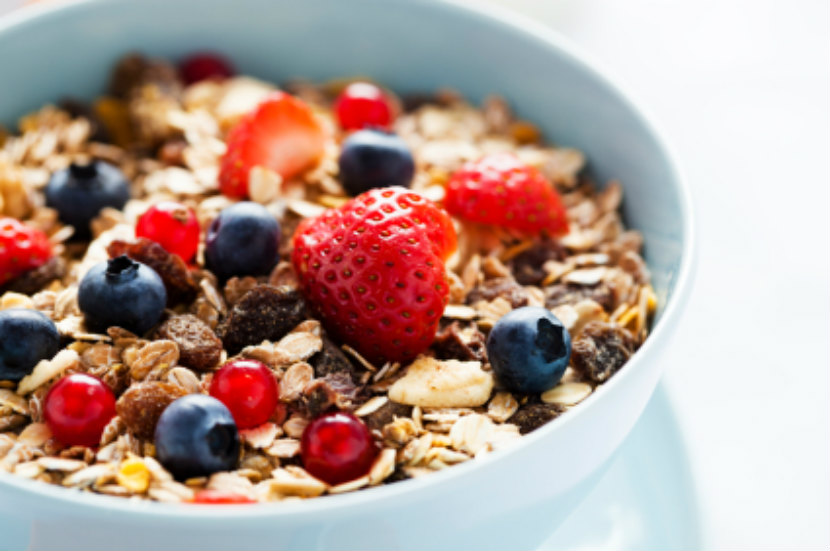
What do chickpeas, apples and almonds have in common? They all contain fibre. Fibre is a carbohydrate that passes through the digestive system without being digested.
Fibre can help to:
-
Keep you regular
-
Lower your cholesterol and
-
Control your blood glucose (blood sugar)
Research shows that fibre may also help you maintain a healthy body weight and lower your risk of heart disease and some cancers like colon cancer.
Which foods have fibre?
Fibre is found in vegetables and fruit, whole grains, legumes like beans, peas and lentils and nuts and seeds.
What are the different kinds of fibre?
There are two main types of fibre:
Insoluble fibre helps to keep you regular. Insoluble fibre is found in some vegetables and fruit, whole grains and wheat bran.
Soluble fibre helps to lower cholesterol and control blood glucose. Soluble fibre is found in some fruits like apples and oranges, vegetables like carrots, okra and eggplant, oats, barley, psyllium, and legumes like beans and lentils.
It is important to eat a variety of fibre-rich foods to get the health benefits of both types of fibre.
How much fibre do I need?
Many people only get half the amount of fibre they need. The amount you need depends on how old you are and whether you are male or female. The chart below shows the recommended amount of fibre for children and adults.
|
Age group
|
Recommended amount per day
|
|
Children 1-3 years old
|
19 grams
|
|
Children 4-8 years old
|
25 grams
|
|
Boys 9-13 years old
|
31 grams
|
|
Boys 14-18 years old
|
38 grams
|
|
Girls 9-13 years old
|
26 grams
|
|
Girls 14-18 years old
|
26 grams
|
|
Men 19-50 years old
|
38 grams
|
|
Men 51 and over
|
30 grams
|
|
Women 19-50 years old
|
25 grams
|
|
Women 51 and over
|
21 grams
|
|
Pregnant women
|
28 grams
|
|
Breastfeeding women
|
29 grams
|
To get the health benefits of fibre, slowly increase the amount you eat. Remember to be physically active and drink plenty of fluids. This will help you avoid gas and bloating as you increase the fibre in your diet. Read Facts on Fluids – How to Stay Hydrated to find out how much fluid you need.
How can I get more fibre in my diet?
Below are tips to help you get more fibre in your diet every day.
Grains:
-
When reading food labels, look for breads, bagels, English muffins, pitas, tortillas and wraps with 2 to 4 grams of fibre per serving on the Nutrition Label.
-
Start your day with a high fibre cereal that has 4 grams of fibre per serving.
-
Use whole wheat pasta or brown rice instead of white pasta or white rice for dinner.
-
Substitute whole grain wheat, teff or sorghum flour in place of white flour when baking bread, muffins, chapattis, naan or rotis.
Vegetables and Fruit:
-
Choose whole vegetables and fruits instead of juice. Even 100% juice does not have as much fibre as whole vegetables and fruit.
-
Add a small salad or vegetable soup to your lunch or dinner meal.
-
Bring cut up vegetables and low fat dip as a snack at work or school.
-
Add fresh berries or dried fruit to your favourite yogurt or cereal.
-
Have a fruit salad with low fat dip as a dessert.
Legumes
-
Add lentils or beans to soups, casseroles and salads.
-
Spread hummus on whole grain flat bread, naan or roti.
-
Serve dahl, sambhar, rasam and sundal with lentils and beans.
-
Add soybeans to soups, stir-fry dishes and casseroles.
Nuts and Seeds
-
Add ground flaxseeds to cereal, porridge, roti or tortilla dough or dahl.
-
Mix almonds, sunflower seeds and pine nuts and have a small handful as a snack.
-
Add hazelnuts or dried coconut to baked muffins.
The bottom line
Getting more fibre can be easy by making small changes that will add up throughout the day. Foods like vegetables and fruit, whole grains, legumes, nuts and seeds have the fibre you need. When grocery shopping, compare food labels and choose foods with 2 to 4 grams of fibre per serving.
Last Update – October 31, 2018